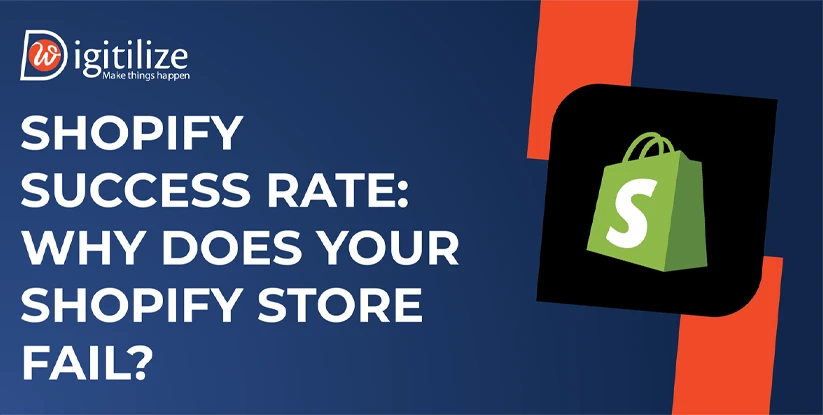Shopify Success Rate: Why Does Your Shopify Store Fail?

Ever wonder why, despite Shopify’s immense popularity, some shops cannot be successful? It is normal to be curious about Shopify’s success rate and believe anybody can build a successful online business, but this isn’t always true. So, let’s explore the Shopify success rate: why does your Shopify store fail?
In ecommerce companies, particularly those operating on the Shopify platform, the success rate is critical as it dictates the potential for income generation. Several tactics to raise your Shopify success rate are covered in this post. We want to help your ecommerce business by offering insightful information gained from successful Shopify shop strategies.
What is the success rate on Shopify?
The majority of estimations agree that the success rate on Shopify is between 5 and 10%. Keep in mind that Shopify doesn’t disclose precise figures, so it’s difficult to determine.Even if the Shopify success rate appears to be rather low, don’t let that stop you! It serves as a helpful reminder of exactly how difficult it is to launch and maintain a new agency. Currently, more than 1.7 million businesses use it as one of the top ecommerce platforms for online sales of goods and services. In the end, success demands a blend of expertise, abilities, experience, and occasionally even a little bit of luck. Sadly, a lot of enthusiastic business owners create Shopify ecommerce websites without really knowing what it takes to be successful.
Top Reason for Shopify’s Failures

-
Absence of a definite goal
It’s possible that customers won’t notice the benefits of purchasing there or won’t know what sets it apart from other online retailers. Additionally, it may be challenging for a Shopify site to stand out from the competitors if it has a distinct purpose or value offer.
-
Ineffective marketing techniques
Even while they are useful channels, they might not be sufficient to bring in a sizable amount of money. Search engine optimisation (SEO), email marketing, paid advertising, social media, and other channels should all be part of a well-thought-out marketing plan for a Shopify business. Overspending on a single marketing channel without conducting any testing or analysis of the outcomes is another error.
-
No traffic
To ensure that customers can quickly locate your items on Shopify, every word of your website must be optimised for Google search, particularly if you are marketing in a market with a lot of competitors.
In order to ensure that your store page appears when someone searches for your work, you should strive to get knowledgeable about SEO and other internet marketing strategies that will get you listed on Google.
-
Not prioritising design for mobile
-
Selecting inappropriate products
Failure can also result from selling goods that are oversaturated or too competitive in the market. If well-known companies or brands are providing comparable goods, it might be challenging for a new Shopify site to compete.
-
Restricted payment options
-
Cut down on product revenue
This section’s justifications may not always apply to Shopify ecommerce websites. These just hold for each internet retailer. Nonetheless, you have an advantage over the competition if you use Shopify as your platform. Let’s now talk about the tactics needed to succeed on Shopify.
How to make your Shopify store successful

-
Make a captivating brand narrative for your shop.
There should be more to your Shopify business than just an online product catalogue. It needs to represent your unique qualities as a company owner and set you apart from the competition. Because of this, it’s critical to create a compelling brand narrative that appeals to your target audience and explains to them why they should choose to purchase from you over another retailer.
-
Customise the Look and Feel of Your Store with Shopify
From this point on, you can:
-
- Use your company’s colours, fonts, and logo to personalise the theme.
- Organise your menus such that navigating around is simple.
- To engage your audience, provide eye-catching product photos and captivating descriptions.
-
Employ email marketing
Given how much longer email has existed than social media, it’s understandable that people aren’t very enthusiastic about it. Email, however, has the potential to exceed all other marketing initiatives in terms of return on investment for your marketing spend. Depending on how many subscribers you have, you may utilise a lot of software—either free or inexpensive—to automate your email marketing.
-
Utilising Google Analytics to monitor visitor behaviour
For instance, if you observe that a lot of people are coming to your website in search of a particular item but aren’t finding it, find out what else they could be looking for and provide content that addresses their requirements. They will interact with your website more thoroughly as a result, increasing the likelihood that they will make a purchase.
-
Proper product description
Ensure that the product description you have, complete with images, costs, and delivery details, is correct and clear. Include the noticeable “Add to Cart” button on your product page to further improve it. Don’t forget to include a thorough overview of all the features and benefits of each product and service. Use bullet points to break up the text so that readers may read it more easily and stay interest.
Top Two Indicators That Your Shopify Store Is Successful
-
High volume of website visitors
The majority of Shopify websites track daily visitors. Stated differently, they figure out how many people come in every day. Websites with a lot of traffic track their visitors hourly. Sites with extremely high traffic count visitors per minute. Generally speaking, you should be encouraged if more people are visiting your website. Nevertheless, the second lesson is that getting consumers in the door isn’t what makes you money.
-
Revenue
Nonetheless, you can discover that the majority of goods have a minimum 50% gross margin. If the margins in your shop are so thin that it’s a warning indication of disaster. This indicates that either your expenditures are excessive or your product pricing is incorrect.

It’s never been simpler to launch an ecommerce company in UK, and Shopify offers an easy-to-use option for anyone who wants to stay away from complex software and processes. Still, figuring out how to achieve this may be a difficult undertaking. With any luck, this post has already started you on the right path to learning about Shopify’s success rate and how to build a successful business. Understanding the significance of every stage in the development of your Shopify business is essential.
Following the completion of these procedures, there will be a greater likelihood of increased traffic, sales, and a higher success rate for your Shopify business. Your store’s chances of success are not entirely zero, though. For this reason, you should refer to advice and ask for assistance from professionals. Our vast network of skilled Shopify experts at DigitilizeWeb is constantly ready to take your business to the next level and help you maintain your competitive edge in the market. To know more follow us on LinkedIn.
FAQ
Frequently Asked Questions
Yes, Shopify provides a free trial period during which you may set up your store. To keep operating your business beyond the trial, you'll need to decide on a pricing strategy.
In a few hours, you can have the foundations of your Shopify store operational. It could take many days to finalise the backend settings, content, and user experience.
It is feasible to generate revenue with Shopify. Many internet merchants have made good money by selling goods through their Shopify stores. But each business has a different chance of success, and to make money on Shopify, one needs to work hard, be creative, and be able to adjust to changing market conditions.
It is possible to have more than one Shopify store on a single account. With Shopify, you can set up, up to ten stores on one account, each complete with its own domain name, items, settings, and other details.
A Shopify company may indeed turn a profit. After two years, 81% of Shopify's merchants are profitable, according to the company.
The greatest e-commerce site for dropshipping companies is Shopify. You may automate order fulfilment and shipment by connecting your business directly to networks such as Amazon and AliExpress using Shopify applications.

